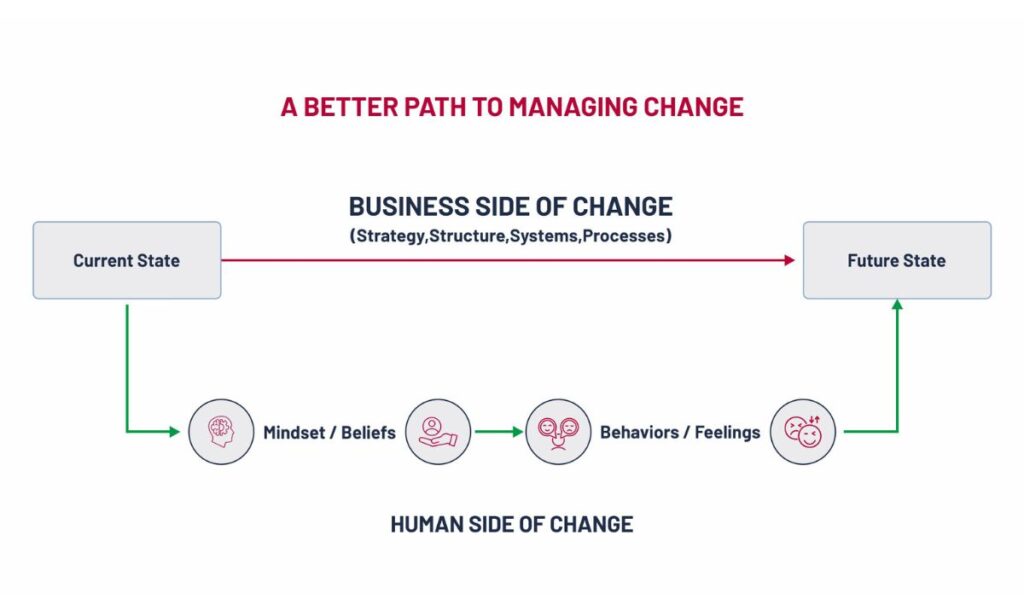Preface:
In the dynamic landscape of organisation change, a great business initiative alone falls
short. While a well-crafted initiative lays the groundwork, it is the collective mindset and
behaviors that ultimately determine the success or failure of the initiative.
Business leaders often rush into execution without fully considering the complexities of
their initiatives. While this may work for simple change effort, it often meets resistance
with applied to more complex change efforts. In this blog, we will explore some of the
reasons and share what I call a ‘better path to managing change’.
Understanding the ‘why’ of the familiar path
The bias for action is so strong across companies, that we are constantly in the
‘busyness’ mode’. Below we will explore some of the reasons why we fall in the trap of
jumping from ‘idea’ to ‘action’ only to later realize the pitfall of this approach.
- Overemphasis on strategy: There’s often a tendency to overemphasize the strategic aspects of the initiative / idea over the human elements.
- Time pressure: Management is under constant pressure to demonstrate outcomes and deliver results
- Mindset and behavior not being tangible: another reason is that mindset and behavior are not tangible outcomes and therefore not measurable. Therefore, emphasis is given on implementation, which is visible.
- Leadership blind spot: one of the most interesting conversations I had with a CFO, was when he confessed that this is a leadership blind spot. The management tends to underestimate the significance of mindset shifts.
- Lack of capability: Also it emerged that there is a general lack of capability within organizations to focus on mindset and behaviors in a systemic way. The most common form of influence remains communication and branding efforts, which is not really the same.
“Mindset and behaviors are the twin engines that drive the locomotive of change. Together they form the transformative power needed to navigate the complexities of change”
A better path to managing change - Mindset and Behavior
The Mindset of change involves a willingness to embrace uncertainty, and a readiness
to challenge the status quo. It is about being open to new ideas, approaches and
perspectives as a necessary component for growth and progress. One of the main
challenges is overcoming individual and collective resistance to change. The key
stakeholders during this process are actually the leader and the leadership team as
their unequivocal support and sponsorship is critical to the success and adoption. Today
there are tools available that facilitate shifting mindsets, one such being the ‘Immunity to
Change’ work by Prof Robert Keegan.
The behavior component of change includes feelings and emotions exhibited by
individuals and groups in response to change. There are 3 aspects to be kept in mind
for the behavioral aspects of change. First is the Co-creation. People are more willing to
accept change, when their views and opinions have been factored in. It is a shift away
from the top-down approach to change. The second part of behaviors include ‘how the
leadership shows up’ during the lifecycle of change. We have to remember that leaders
are always on the stage and have to lead by example. When leaders walk the talk and
demonstrate consistent behavior, it has a positive influence on the organisation psyche.
The third component of behavior is around the group dynamics especially amongst the
leadership team. This is closely tied to the second point and employees are observing if
the leadership projects a united stand and how they collaborate amongst each other.
“True transformation begin within the corridors of the mind, where old habits yield to the seeds of new possibilities”
Conclusion
In conclusion, successful organisation change relies heavily on the interplay between
the Business side of change and the Human side of Change. While strategies and plans
are crucial for implementing change, it is the mindset and behaviors that make change
stick.
Embracing this holistic approach ensures that employees are more resilient and
adaptive to change, ultimately helping the organisation move towards its goals with
confidence.
Srikanth is the founder of Vruddhi India, a management consulting firm focused on Change leadership practices. We specialize in guiding companies through the complexities of change in a way that is uniquely personal and customized. You can email me at srikanth.pv@vruddhiindia.com for more information.

Srikanth,You have captured the change success determinants in a simple and clear manner.It has been the wont of Senior Leadership to underestimate the crucial role the employee mindsets,feelings play in a change scenario.Also the time estimated for a change to be implemented and institutionalised is compressed totally.